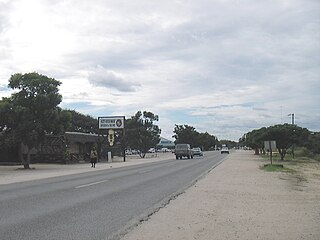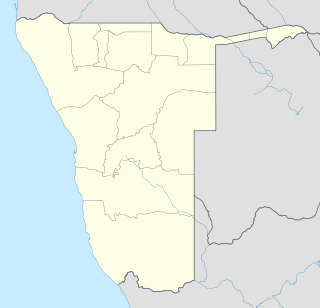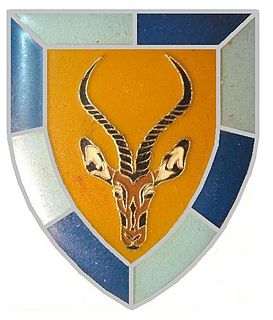
Kavango was one of the thirteen regions of Namibia until it was split into the Kavango East and Kavango West Regions in 2013. Its capital was Rundu.
Sekele is the northern variety of the !Kung dialect continuum. It was widespread in southern Angola before the civil war, but those varieties are now spoken principally among a diaspora in northern Namibia. There are also a number of dialects spoken in Northernmost Namibia.
Namlish is a form of English spoken in Namibia. English is the country's official language since independence in 1990. Because it is the second or third language for the majority of the Namibians, local usage can vary significantly from usage elsewhere in the English-speaking world. Namibian English, or Namlish, shares many similarities with South African English, having been influenced both by Afrikaans and indigenous African languages.

Rundu is the capital of the Kavango-East Region, northern Namibia, on the border with Angola on the banks of the Kavango River about 1,000 metres above sea level. The place normally receives an annual average rainfall of 565 millimetres (22.2 in), although in the 2010/2011 rainy season 757 millimetres (29.8 in) were measured.
ISO 3166-2:NA is the entry for Namibia in ISO 3166-2, part of the ISO 3166 standard published by the International Organization for Standardization (ISO), which defines codes for the names of the principal subdivisions of all countries coded in ISO 3166-1.
Rev. Samuel Kaveto Mbambo is a Namibian politician, diplomat, theologian, historian, and academic. He is the Governor of the Kavango-East Region, and a former ambassador of the Republic of Namibia to the Russian Federation, not resident in Ukraine. He previously served as Namibia's High Commissioner to the Republic of India.

Nkurenkuru is a town on the south-western banks of the Kavango River. It is the capital of the Kavango West Region of northern Namibia, located 140 kilometres (87 mi) west of Rundu. It is also a former mission station of the Finnish Missionary Society.

Mpungu is a constituency in the Kavango West region of Namibia. Its population is 18,332. Nkurenkuru, the capital of Kavango West, is situated in this constituency. The Mpungu settlement is also located here.
Gciriku is a traditional Kavango kingdom in what is today Namibia. Its people speak the Gciriku language.
Sebastian Kamwanga was a Hompa (king) of the Gciriku, one of five kingdoms of the Kavango people in northern Namibia, from 1985 to 1999. His royal seat was situated at Mamono. He sat in the Legislative Council and the Executive Council of Kavangoland from 1973 until Namibian independence in 1990 when Bantustans were abolished along with the South African apartheid occupation of South-West Africa.

Kavango East is one of the fourteen regions of Namibia. Its capital is Rundu. Because of its rather higher rainfall than most other parts of Namibia, this region has agricultural potential for the cultivation of a variety of crops, as well as for organised forestry and agro-forestry, which stimulates furniture making and related industries.

Kavango West is one of the fourteen regions of Namibia. Its capital is Nkurenkuru. The Region was created in 2013 when the Kavango Region was split into Kavango East and Kavango West.
Ncamangoro Constituency is an electoral constituency in the Kavango West Region of Namibia. It was created in August 2013, following a recommendation of the Fourth Delimitation Commission of Namibia, and in preparation of the 2014 general election. The administrative centre of Ncamangoro Constituency is the village of Ncamangoro.
Nkurenkuru Constituency is an electoral constituency in the Kavango West Region of Namibia. It was created in August 2013, following a recommendation of the Fourth Delimitation Commission of Namibia, and in preparation of the 2014 general election. The administrative centre of Nkurenkuru Constituency is the town of Nkurenkuru.
Tondoro Constituency is an electoral constituency in the Kavango West Region of Namibia. It was created in August 2013, following a recommendation of the Fourth Delimitation Commission of Namibia, and in preparation of the 2014 general election. Tondoro Constituency is named after the village and mission station Tondoro, although the administrative centre is in the village of Mburuuru.

102 Battalion(pronounced as one-o-two Battalion) was a quick-reaction unit of the South West African Territorial Force. The battalion lost 36 men.







